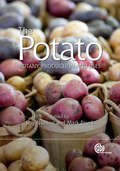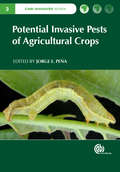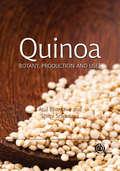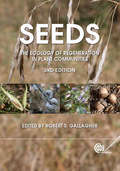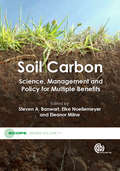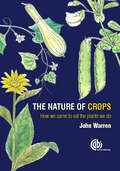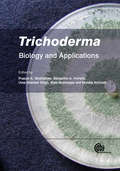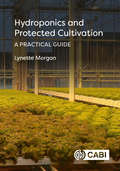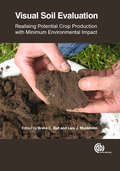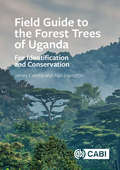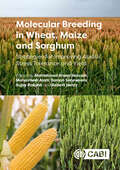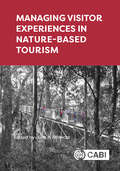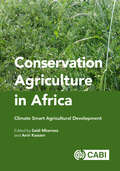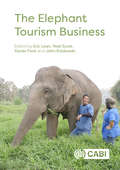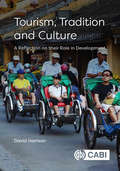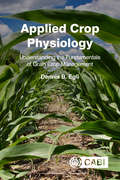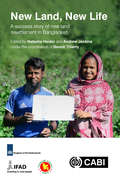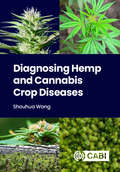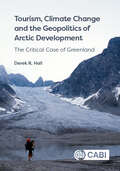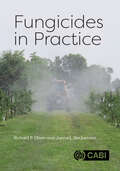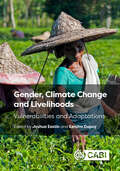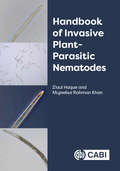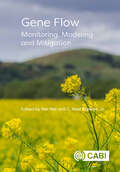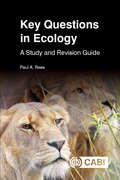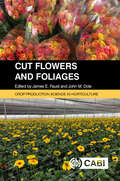- Table View
- List View
Potato: Botany, Production and Uses (Botany, Production and Uses)
by Richard Veilleux Rich Novy Roger Jones Howard Davies William Kirk Vivian Blok Bjorn Kloosterman Roland van den Berg Chuck Brown Paul Bethke Jennifer Bond Ian Burke A Bussan Wesley Everman Loretta Mikitzel Mark Stalham David Wattie Kaiyun Xie Albert Abbott Carrie Wohleb Mark Taylor Andy Jensen Tim Waters Robert RobertPotatoes are a staple crop around the world. Covering all aspects of botany, production and uses, this book presents a comprehensive discussion of the most important topics for potato researchers and professionals. It assesses the latest research on plant growth such as tuber development, water use and seed production, covers all aspects of pest management and reviews postharvest issues such as storage, global markets, and of course, nutritional value and flavour.
Potential Invasive Pests of Agricultural Crops
by Jose Romeno Faleiro Alvaro Castañeda Vildózola Robert Haack Crebio Avila Jose Roberto Parra Mark Hoddle Alberto Urbaneja Ana Diaz Montilla Juli Gould Andrea Birke Aldo Malavasi V Satarkar Raymond Gagne Juliet Goldsmith J. Ramon Valiente Jose Carlos Rodrigues Cal Welbourn Denise Navia Amy Roda Mark Culik J Alvarez Takumasa Kondo Gregory Evans Kenneth Storey Michael Hennessey David Bartels Anne Roy Ana Isabel Gonzalez Greg HodgesInvasive arthropods cause significant damage in agricultural crops and natural environments across the globe. Potentially threatened regions need to be prepared to prevent new pests from becoming established. Therefore, information on pest identity, host range, geographical distribution, biology, tools for detection and identification are all essential to researchers and regulatory personnel. This book focuses on the most recent invasive pests of agricultural crops in temperate subtropical and tropical areas and on potential invaders, discussing their spread, biology and control.
Quinoa: Botany, Production and Uses (Botany, Production and Uses)
by Atul Bhargava Shilpi Srivastava* Quinoa is an invaluable crop, highlighted by the FAO as one of the world’s main crops for future food security * Timely publication – The year 2013 has been declared "The International Year of the Quinoa" (IYQ), recognizing the Andean indigenous peoples, who have maintained, controlled, protected and preserved quinoa as food for present and future generations thanks to their traditional knowledge and practices of living well in harmony with mother earth and nature. * Covers the history, phylogeny and systematics, botany and agrotechnology
Seeds: The Ecology of Regeneration in Plant Communities
by Robert S. GallagherThis 3rd edition highlights many advances in the field of seed ecology and its relationship to plant community dynamics over recent years. It features chapters on seed development and morphology, seed chemical ecology, implications of climate change on regeneration, and the functional role of seed banks in agricultural and natural ecosystems.
Soil Carbon: Science, Management and Policy for Multiple Benefits
by Dave Abson Christiano Ballabio Francesca Bampa Andre Bationo Niels Batjes Martial Bernoux Tapas Bhattacharyya Daniel Buschiazzo Carlos Eduardo Cerri Rich Conant Heitor L.C. Coutinho Chris Duffy Christian Feller Roger Funk Patrick Gicheru Marty Goldhaber Hans Joosten Pierre-Alain Maron Luca Montanarella Generose Nziguheba Genxing Pan Unai Pascual David Powlson Pete Smith Meine Van Noordwijk Bas Van Wesemael David Werner Yongcun ZhaoThis book brings together the essential evidence and policy opportunities regarding the global importance of soil carbon for sustaining Earth's life support system for humanity. Covering the science and policy background for this important natural resource, it describes land management options that improve soil carbon status and therefore increase the benefits that humans derive from the environment. Written by renowned global experts, it is the principal output from a SCOPE rapid assessment process project.
Nature of Crops, The: How we came to eat the plants we do
by Professor John WarrenHave you ever wondered why we eat wheat, rice, potatoes and cassava? Why we routinely domesticate foodstuffs with the power to kill us, or why we chose almonds over acorns? Answering all these questions and more in a readable and friendly style, this book takes you on a journey through our history with crop plants. Arranged into recurrent themes in plant domestication, this book documents the history and biology of over 50 crops, including cereals, spices, legumes, fruits and cash crops such as chocolate, tobacco and rubber. In The Nature of Crops John Warren reveals: -Why the Egyptians worshipped onions; -Why red-flowering runner beans provide fewer beans than white-flowering; -The inherent dangers of being a pineapple worker; and -Why a bird will always beat you in a chilli pepper eating competition!
Trichoderma: Biology and Applications
by Lea Atanasova Bryan A Bailey Scott E Baker Yariv Brotman Sergio Casas-Flores Hexon Angel Contreras-Cornejo Irina S Druzhinina Fabian Glaser Rita Gorsche Oliver Grovel Lorant Hatvani Alfredo Herrera-Estrella B A Horwitz Walter M Jaklitsch Sue Karagiosis Charles M Kenerley Idit Kosti Laszlo Kredics Svetlana Kryštofová David Laughlin Jose Lopez-Bucio Astrid R Mach-Aigner Robert L Mach R L Melnick Laszlo Manczinger Artemio Mendoza-Mendoza Mala Mukherjee Prasun K Mukherjee Randy Ortiz-Castro Yves Francois Pouchus Catherine Roullier Nicolas Ruiz Karina Petit Monika Schmoll Claire Sallenave-Namont Rainer Schuhmacher Matthias G Steiger Martin Simkovic U S Singh Alison Stewart Johanna Steyaert Csaba Vagvolgyi Walter A Vargas Ludovit Varecka Richard J Weld Najam S Zaidi Susanne ZeilingerTrichoderma spp. are biotechnologically significant fungi, being widely used both in agriculture and industry. These microbes are also a potential drug source of clinical importance. In recent years, driven by advances in genetics and genomics, research on these fungi have opened new avenues for its varied applications. Divided into three sections, covering taxonomy and physiology, interactions with plants and applications and significance, this book also discusses topics that have seen rapid developments in the recent years. Various aspects of Trichoderma like molecular taxonomy, sexual and asexual developments, secondary metabolism, beneficial interactions with plants, applications as cell factories and harmful interactions with humans are discussed. This book, thus, hopes to be an essential ready reference for researchers, students and people form industry as well.
Hydroponics and Protected Cultivation: A Practical Guide
by Dr Lynette MorganA comprehensive, practical text which covers a diverse range of hydroponic and protected cropping techniques, systems, greenhouse types and environments. It also details the use of indoor plant factories, vertical systems, organic hydroponics and aquaponics. Worldwide hydroponic cropping operations can vary from large, corporate producers running many hectares of greenhouse systems particularly for crops such as tomato, cucumber, capsicum and lettuce, to smaller-scale growers growing fresh produce for local markets. Included in this book: Detailed technical information to help growers and students to design and run their own hydroponic operations. In-depth research to explain the factors that influence plant growth, produce quality, post-harvest life and hydroponic plant nutrition. New advances such as the use of organic nutrients and substrates, completely enclosed indoor plant factories and the growing number of small-scale, non-commercial applications. Hydroponics and Protected Cultivation is fully illustrated with colour images and photographs to illustrate key topics and help identify problem areas. It is suitable for growers, researchers and students in horticulture.
Visual Soil Evaluation: Realizing Potential Crop Production with Minimum Environmental Impact
by Anne Weill Lothar Mueller Tom Batey Joanna Cloy Mary Norton Scherbatskoy Rachel Guimarães Dick GodwinVisual Soil Evaluation provides land users and environmental authorities with the tools to assess soil quality for crop performance. An important tool for ensuring food security, this book appraises the use of visual soil evaluation in determining the potential of different land types for carbon storage, greenhouse gas emissions and nutrient leaching. Providing a guide to diagnosing and rectifying soil problems, it includes: - Full colour illustrations throughout to show variation of soil quality and aid evaluation - A broad range of land types, from abandoned peats to prime arable land - Assessment of soil structure after quality degradation such as compaction, erosion or organic matter loss Essential reading for students, researchers and scientists interested in soil science and crop production, this book is also a valuable tool for policy makers and environmental authorities. A useful handbook assessing yield potential across a range of scales, it places visual soil evaluation in the context of the future sustainable intensification of agriculture.
Field Guide to the Forest Trees of Uganda: For Identification and Conservation
by James Kalema Alan HamiltonThis book is a guide for the identification of the indigenous forest trees of Uganda. It will be useful for those who wish to contribute towards the conservation of the forests or to plant indigenous trees. Information is provided on how to propagate and cultivate about 80 of the most valuable species. Indigenous trees provide numerous resources useful for welfare and development. They include many types of timber and non-timber forest products, such as craft materials, foods and medicines. The proximity of indigenous forest helps to moderate the local climate, making it more suitable for agriculture. Indigenous forests protect springs, therefore safeguarding water supplies more effectively than exotic trees such as pines and eucalyptus. All 450 known indigenous tree species from the forests are included. Both scientific and local names are provided, the latter in 21 languages. Local names facilitate access to knowledge and values traditionally attached to the species, useful when planning pathways of development firmly rooted in local culture. The book will be invaluable for botanists, foresters, rural development workers and members of the general public concerned about contributing to conservation and sustainable development in Uganda. Many of the species grow in neighbouring countries, so the book has relevance there too.
Molecular Breeding in Wheat, Maize and Sorghum: Strategies for Improving Abiotic Stress Tolerance and Yield
by Pradeep Kumar Natasha Sharma Shabir Hussain Wani Santosh Kumar Muhammad Sarwar Khan Charan Singh Rod Snowdon Pardeep Kumar Professor David Edwards Andrea Acuna Muhammad Amjad Ali John Amalraj Maria Arguello Arushi Arora Diana Ballesteros Bhoja R Basnet Salma Bhyan Richard Boyles Faïçal Brini Yibo Cao S Antony Ceasar Nidhi Chakma Subhadra Chakrabarty Moutoshi Chakraborty Harmeet Singh Chawla Dharampal Choudhary Mukesh Choudhary M C Dagla Mônica Furaste Danilevicz Abhijit Kumar Das Haixiao Dong Kate Dreher Susanne Dreisigacker Xiaorong Fan Maria Laura Federico Cassandria Tay Fernandez Ertugrul Filiz Monika Garg Claudia Teixeira Guimaraes Karama Hamdi K Hariprasanna Firoz Hossain Guanghui Hu Zhaorong Hu B S Jat Caifu Jiang Faiz Ahmad Joyia Mehar Kamboj Chikkappa Karjagi Lovenpreet Kaur Emna Khanfir Rajesh Khulbe Bhupender Kumar Firat Kurt Zhao Li Yun-Hua Liu Ningthaipuilu Longmei Damar Lopez-Arredondo Jurandir Vieira de Magalhaes T Maharajan Jacob Marsh R. Esten Mason Clémentine Mercé Ghulam Mustafa Vignesh Muthusamy Sudha K Nair Zhongfu Ni Kazutoshi Okuno Geoffrey Onaga Huiru Peng Jorge Fernando Pereira Sacn Perera Bhukya Prakash Lydia Pramitha P Rajendrakumar Mantena Raju Savaram Vr Rao Ali Razzaq P Sanjana Reddy Trenton Roberts G Victor Roch Umesh R Rosyara Pawan Saini Sindhu Sareen Gajanan Saykhedkar André Schaffasz Armin Scheben Tariq Shehzad Sonia Sheoran Ishwar Singh Prabha Singh Vishal Singh Nithya Subramanian Qixin Sun Madhumal Thayil Vinayan Yiqiao Wang Steffen Windpassinger Kerstin Wydra Yinping Jiao Mingming Xin Ines Yacoubi Pranjal Yadava Yingyin Yao Kuohai Yu Yaping Yuan Pervez Haider Zaidi Hong-Bin Zhang Meiping Zhang Zhiwu Zhang Rajkumar U ZunjareThe global population is projected to reach almost 10 billion by 2050, and food and feed production will need to increase by 70%. Wheat, maize and sorghum are three key cereals which provide nutrition for the majority of the world's population. Their production is affected by various abiotic stresses which cause significant yield losses. The effects of climate change also increase the frequency and severity of such abiotic stresses. Molecular breeding technologies offer real hope for improving crop yields. Although significant progress has been made over the last few years, there is still a need to bridge the large gap between yields in the most favorable and most stressful conditions. This book: - Provides a valuable resource for wheat, maize and sorghum scientists working on breeding and molecular biology, physiology and biotechnology. - Presents the latest in-depth research in the area of abiotic stress tolerance and yield improvements. - Contains the necessary information to allow plant breeders to apply this research to effectively breed new varieties of these crops. It provides a consolidated reference for plant breeders and crop scientists working on the challenges of enhanced crop productivity and climate change adaptability.
Managing Visitor Experiences in Nature-based Tourism
by Ali Thompson Mick Abbott Karl Agius Mary E. Allen George Ariya Rocío Blanco-Gregory Cameron Boyle Robert C. Burns Kadir Çakar Eugenio Conti Fernando Enseñat-Soberanis Sonia Ferrari Peter Fredman Azizul Hassan Stuart Hayes Nicolaia Iaffaldano Woody Lee Tiago Lopes Brent Lovelock Andrés Ried Luci Lusine Margaryan Johnathan Mondragón-Mejía Ana Goytia Prat Haywantee Ramkissoon Francisco Silva Jeffrey C. Skibins Ismail UzutThis book focuses on the experiences of tourists visiting nature-based destinations, exploring current knowledge and providing insights into conceptual issues through the use of empirical evidence from five continents. Presented as three topics, the contents discuss tourism and nature-based experiences by looking at the role and relevance of nature and the uniqueness of such experiences. The book identifies visitor management challenges and provides explanations for the solutions reached. The final section takes a more overarching destination management perspective that transcends the tourism product or business level and focuses on destination and generic issues like indicators or marketing implications. The book also includes research-based case studies which contribute to an overall understanding of the core issues involved in managing visitor experiences in nature-based tourism.
Conservation Agriculture in Africa: Climate Smart Agricultural Development
by Mohamed Annabi Haithem Bahri Mloza Banda Gotlieb Basch Richard Bell Alexandra Bot Trent W Bunderson Martin Bwalya Hatem Cheikh M’hamed Cornelius Chiduza Cary Clark Demba Diakhaté Mazwi Dlamini Sjoerd Duiker Alioune Fall Aymen Frija Patrick Gicheru Josiah Gitari Tom Goddard Emilio Gonzalez-Sanchez Isaac Gura Enamul Haque Michel Havard Zied Idoudi Mohammad Jahiruddin Zwide D Jere Josef Kienzle Onesmos Kitonyo Erna Kruger Peter Kuria Phlorentin Philip Lagwen Simon Lugandu Ngari Macharia Temakholo Mathebula Sixolise Mcinga Alfred Micheni Neil Miller Frank Mmbando Rachid Moussadek Pearson Nyari Mnkeni Rachid Mrabet Ndabhemeye Mulengera Walter Mupangwa Joseph Mureithi R. M. Museka Weldone Mutai Munyaradzi Mutenje Lindah Muzangwa Remmy Mwakimbwala Andre A Nel James Njeru Rama Ngatoluwa Phumzile Ngcobo Isaiah Nyagumbo Putso Nyathi Ricardo Ralisch Leonard Rusinamhodzi John Sariah Ibrahima Sarr Peter Setimela Richard Shetto Reynolds K. Shula Brian G. Sims Hendrik J. Smith Dimas Soares Júnior Peter Steward Johann Strauss Christian Thierfelder Gerhardus Trytsman Jean Twilingiyumukiza Carl Wahl Peter Waweru Nouhoun ZampaligreTillage agriculture has led to widespread soil and ecosystem degradation globally, and more particularly in the developing regions. This is especially so in Africa where traditional agricultural practices have become unsustainable due to severe exploitation of natural resources with negative impacts on the environment and food system. In addition, agricultural land use in Africa today faces major challenges including increased costs, climate change and a need to transform to more sustainable production intensification systems. Conservation Agriculture has emerged as a major alternative sustainable climate smart agriculture approach in Africa and has spread to many African countries in the past decade as more development and research, including in sustainable mechanization, has enabled its extension and uptake. It is key to transforming Africa's agriculture and food system given its ability to restore soil health, biodiversity and productivity of millions of smallholder farms as well as larger-scale farms. This landmark volume is based on the material presented at the Second Africa Congress on Conservation Agriculture which was held in Johannesburg, South Africa, 9-12 October 2018. The main theme of the Congress was 'Making Climate Smart Agriculture Real in Africa with Conservation Agriculture: Supporting the Malabo Declaration and Agenda 2063'. The Congress was aligned to mobilize stakeholders in all agriculture sectors to provide greater technical, institutional, development and investment support, impetus and direction to the vision and agenda for transforming African agriculture as set out by the Malabo Declaration and Agenda 2063. This book is aimed at all agricultural stakeholders in the public, private and civil sectors in Africa engaged in supporting the transformation of conventional tillage agriculture to Conservation Agriculture. The book will be of interest to: researchers, academics, students, development stakeholders, public and private sector investors and policy makers as well as institutional libraries across the world.
The Elephant Tourism Business
by Ann Suwaree Ashton Liv Baker Sumanth Bindumadhav Sarah Blaine Eric Brymer Naphawan Chantradoan Saranphat Chotmanakul Qingming Cui Susanna Curtin Charlotte Day Nilakshi Galahitiyawe Vivek Gurusamy Professor Xavier Font Nicole Hausler Jeffrey Dale Hobbs Claire Jenkinson Professor John Koldowski Naut Kusters Eric Laws Shilpa Mahbubani Andrew McLean Mucha Mkono Somyot Ongkhluap Anja Pabel Piengpen Na Pattalung Clive Phillips Kannapa Pongponrat Bongkosh Rittichainuwat John Edward Roberts Andrea Saayman Melville Saayman Jan Schmidt-Burbach Professor Noel Scott Alokparna Sengupta Vinathe Sharma-Brymer Ramona Strödecke Daminda Sumanapala Daniel Turner Marjorie Van Strein Rebecca Winkler Isabelle Wolf Honggang XuElephant tourism is a growing activity in many countries across Asia and Africa and is popular with tourists from all parts of the world. Elephant tourism has grown rapidly, providing the only viable way for elephants and their owners to survive since the banning of logging. Old logging camps have been developed into sanctuaries for some elephants, but many other camps were established as entertainment centres, resulting in serious welfare issues for the elephants and their mahouts. The profits from elephant tourism in Asia have encouraged African operators to follow a similar business model. This book draws attention to the need for a comprehensive and rigorous focus on local solutions to improve the welfare of captive elephants, their mahouts and local residents, and to enhance tourists' experiences of elephant tourism. It achieves this by: - Critically reviewing recent research into elephant tourism. - Providing contemporary analytical case studies of elephant tourism policy and practice. The Elephant Tourism Business will contribute to a better understanding of how elephant tourism is organised, regulated and promoted, both in elephant areas and tourist origin countries. It identifies priorities for future research into elephant tourism and provides a unique, authoritative resource for researchers, elephant managers and administrators, and tourism managers. The book will be of interest to academics and practitioners with backgrounds in conservation, the environment, tourism and veterinary sciences, and will appeal to tourists keen to experience elephants in person.
Tourism, Tradition and Culture: A Reflection on their Role in Development
by David HarrisonDavid Harrison has contributed to the academic study of tourism over the last 30 years. This book brings together a collection of his published material that reflects the role played by tourism in 'development', both in societies emerging from Western colonialism and in societies previously part of the Soviet system. The overarching theme looks at how, promoted as a tool for development, tourism can lead to conflict between competing elites, but can also empower groups previously subject to constraint by traditional authorities. Tradition is intensely manipulatable and always reflects power relations. Such pressure on tradition is but one aspect of tourism's wider social impacts. This includes changes in economic and social structure, which, for many, constitute social problems that need to be addressed. At the same time, 'sustainability', though apparently a worthy aim, can be a problematic concept, especially when applied to 'traditional' cultures, and may conflict with such ideals as egalitarianism.
Applied Crop Physiology: Understanding the Fundamentals of Grain Crop Management
by Dennis EgliThis book presents a simple, straightforward discussion of the principles and processes involved in the production of grain yield by agronomic crops, and how these processes underlie and influence management decisions. The focus is on grain crops, principally maize and soybean, although the general principles apply equally well to cereals, grain legumes and oil crops. Management decisions define all cropping systems - what (crop species, variety), where (climate), when (planting date), and how (row spacing and population density) are the fundamental choices. Knowledge of the fundamental processes responsible for plant growth and the accumulation of yield simplifies the decision-making process and leads to improved management decisions, higher grain yields, and cropping systems that are efficient, resilient and sustainable. The contents include: · Basic plant growth processes e.g. photosynthesis, respiration, evapotranspiration · Growth and production of yield · Crop management - seed quality, variety selection, plant date, row spacing · Crop production in the future - climate change, GMOs, precision data and new crops Intended for researchers in crop science, agronomy and plant science, and crop production practitioners, this book will enable readers to make better, more informed management decisions; decisions that will help maintain a well-fed world in the future.
New Land, New Life: A success story of new land resettlement in Bangladesh
by Bazlul Karim Mihir Kumar Chakraborty Kiran Sankar Sarker Md. Rezaul Karim Md. Robiul Islam Nujulee Begum Edward Mallorie Koen De WildeThe Ganges-Brahmaputra-Meghna delta has newly emerged 'char' islands, resulting from the deposition of sediment, which are very vulnerable, socially, institutionally and environmentally. This book explains how the governments of Bangladesh and the Netherlands and the International Fund for Agricultural Development cooperated on a land-based rural development project to give settlers security and purpose. It details how they engaged communities and civil societies, and implemented an infrastructure aimed at reducing flooding, improving drainage, and providing adequate drinking water and sanitation. The book describes the project's application to crop and animal agriculture, and the development of value chains and encouragement of female participation. It considers the financial underpinning and infrastructure, as well as how to ensure the impacts of the scheme are enduring. The scheme serves as a model for support projects to vulnerable groups faced with climate change and other environmental challenges. This book is suitable for students, researchers, specialists and practitioners in rural development, water resources, land management and soil science.
Diagnosing Hemp and Cannabis Crop Diseases
by Dr Shouhua WangHemp and cannabis, both belonging to Cannabis sativa, have emerged as some of the most valuable crops because of their multiple functionalities - industrial, medicinal, and recreational uses. Like all other crops, they are at risk of diseases and pests. In certain cases, an entire hemp field can fail due to unexpected disease. As a new and highly regulated crop, research on Cannabis crop diseases is scarce, and the science of plant diagnostics is not well covered in the literature. Taking hemp/cannabis as a model crop, the book illustrates how to diagnose a disease problem and how to manage it effectively. It presents real disease cases encountered during crop production, and explains methods of diagnosis, both in the field and in the lab, in order to find out the cause(s). The book provides: ·A field and laboratory guide to diagnosing hemp and cannabis diseases and pest problems ·Ready-to-adopt skills, methods and protocols in plant diagnosis, which can be applied to other crops ·Over 300 colour photographs accompanied by a wealth of disease information, including field observations, unique symptoms, microscopic details, and molecular data. This book is essential for anyone who is interested in learning about Cannabis crop diseases, for crops grown in the field, and in indoor production facilities.
Tourism, Climate Change and the Geopolitics of Arctic Development: The Critical Case of Greenland
by Derek HallGreenland is becoming a critically important territory in terms of tourism, climate change and competition for resource access, yet it has been poorly represented in academic literature. Tourism now features as a major source of income for the territory alongside fisheries. Cruise tourism is increasing rapidly, and might superficially appear to be best suited to Greenlandic conditions, given the lack of large-scale accommodation infrastructure and almost non-existent land routes between settlements. Ironically, one of the most spectacular tourist attractions is the large number of icebergs that are being calved as the result of glacier retreat and ice cap melting, both appearing to be taking place at ever increasing rates. As a consequence of ice removal, the territory's claimed extensive range of mineral resources, not least rare earth elements and hydrocarbons, are becoming more accessible for exploitation and, thereby, are acting increasingly as the focus for geopolitical competition. This book explores the nature of dynamics between tourism, climate change and the geopolitics of natural resource exploitation in the Arctic and examines their interrelationships specifically in the critical context of Greenland, but within a framework that emphasises the wider global implications of the outcomes of such interrelationships. This book is the first to explore these interrelationships in depth in English.
Fungicides in Practice
by Richard P. Oliver Professor Janna L BeckermanThis is an up-to-date guide on the science and practice of disease control based on fungicides in horticulture and broad acre agriculture. It describes how conventional, organic and biological fungicides are discovered, how they work and how resistance evolves. Chapters on formulation, mode of action, mobility and application inform decisions about which fungicides to use, when to use them, and how to rotate (or tank-mix) them, to manage both plant disease and fungicide resistance. A chapter on experimental design of fungicide trials aids practitioners in designing their own trials to evaluate how effective products are for their plant disease problem. Based on the successful 2014 book of Fungicides in Crop Protection this edition has four entirely new chapters, and extensive updates to the other nine chapters. The contents include: · Fungicide markets, discovery and performance. · Modes of action and spectrum. · Biological crop protection, and organic cultivation. · Fungicide formulation, mobility and application. · Experimental design of fungicide trials and their analysis. · Fungicide resistance. · Legislation and regulation. Written for crop protection professionals and scientists, growers, agronomists and consultants, the book is also suitable for students of agriculture and agronomy.
Gender, Climate Change and Livelihoods: Vulnerabilities and Adaptations
by Margaret Alston Salim Momtaz Elizabeth Bryan Muhammad Asaduzzaman Nahid Rezwana Aden Aw-Hassan Elisabeth Garner Patricia E. Perkins Agnes Babugura Bipasha Baruah Abderrahim Bentaibi Quinn Bernier Yvonne Braun Boubaker Dhehibi Diana Hummel Zobaidul Kabir Edward Kato Francis Mwesigye Dina Najjar Balikisu Osman Elizabeth Opiyo Onyango Shahreen ShehwarThis book applies a gendered lens to evaluate the dynamic linkages between climate change and livelihoods in developing countries. It examines how climate change affects women and men in distinct ways, and what the implications are for earning income and accessing the natural, social, economic, and political resources required to survive and thrive. The book's contributing authors analyze the gendered impact of climate change on different types of livelihoods, in distinct contexts, including urban and rural, and in diverse geographic locations, including Asia, Africa and the Caribbean. It focuses on understanding how public policies and power dynamics shape gendered vulnerabilities and impacts, how gender influences coping and adaptation mechanisms, and how civil society organizations incorporate gender into their climate advocacy strategies. This book: -Provides cutting-edge scholarship on an underrepresented area of climate change: the gendered impacts of climate change on livelihoods. -Covers a range of different types of livelihoods and geographic locations. -Involves contributors from a diverse array of cultural and scholarly backgrounds, bringing contrasting perspectives to the topic. This book is recommended for scholars, students, and practitioners who study or work in fields such as climate change, gender, livelihoods, public policy, economic development, and agriculture.
Handbook of Invasive Plant-parasitic Nematodes
by Dr Ziaul Haque Dr Mujeebur Rahman KhanPlant parasitic nematodes are major pests of agricultural crops and cause huge monetary losses. There is a very high risk of spread of plant-parasitic nematodes from one country to another, with the movement of plants and planting materials such as seeds, bulbs, corms, suckers, tubers, rhizomes, rooted plants, nursery stock and cut flowers. In view of the large quantities and the wide variety of materials being imported and exported, it is important to assess the status of invasive nematodes and their quarantine importance in relation to agricultural trade. This book contains information on around 100 invasive nematodes and their potential threat in different countries. Each nematode entry includes information on authentic identification, geographical distribution, risk of introduction, host ranges, symptoms, biology, ecology, planting material liable to carry the nematode(s), nematode vectors, chance of establishment, likely impact, and phytosanitary measures. There are detailed accounts of diagnosis procedures including sampling, isolation, detection and identification of nematodes based on morphological and molecular characters. The book offers a global perspective on invasive plant-parasitic nematodes and useful for practitioners, professionals, scientists, researchers, students, and government officials working in plant quarantine and biosecurity.
Gene Flow: Monitoring, Modeling and Mitigation
by Wei Wei And C. Neal Stewart JrGene flow is a natural process that occurs spontaneously and enables the evolution of life. However, with the release of genetically modified organisms, concerns have focused on introduced foreign transgenes and their dispersal in nature through gene flow. This book examines gene flow of transgenes, such as herbicide resistance genes, with the goal of understanding the factors that may affect the process of gene flow. A greater biological understanding is essential to make sound management regulatory decisions when also taking into consideration the processes that happen in conventional plants. Monitoring, modelling, and mitigation are the three most closely related elements of gene flow. The book includes both scientific reviews and perspectives on gene flow and experimental case studies, including studies of gene flow in soybean and poplar. The authors present diverse views and research methodologies to understand transgene flow. This book: Focuses on applications of gene flow (monitoring, modelling, and mitigation); Includes both review chapters and case studies; Is written by international team of scientists currently working in gene flow. This book will be valuable for students and researchers in genetics, biotechnology, plant science, and environmental science. It also provides key insights of value to regulators of biotechnology as well as policy-makers.
Key Questions in Ecology: A Study and Revision Guide (Key Questions)
by Dr Paul ReesAn understanding of ecology is an important requirement of a wide range of academic areas, including biology, zoology and environmental science. This book is a study and revision guide for students following programmes of study in which ecology is an important component. It contains 600 multiple-choice questions (and answers) set at three levels - foundation, intermediate and advanced - and grouped into 10 major topic areas: · The history and foundations of ecology · Abiotic factors and environmental monitoring · Taxonomy and biodiversity · Energy flow and production ecology · Nutrient and material cycles · Ecophysiology · Population ecology · Community ecology and species interactions · Ecological genetics and evolution · Ecological methods and statistics The book has been produced in a convenient format so that it can be used at any time in any place. It allows the reader to learn and revise the meaning of ecological terms, the basic processes operating in ecosystems, the dynamics of populations, ecological genetics and the process of evolution, the methods used in ecological surveys, and much more. The structure of the book allows the study of one topic area at a time, progressing through simple questions to those that are more demanding. Many of the questions require students to use their knowledge to interpret information provided in the form of graphs, data or photographs, providing a useful tool for independent study.
Cut Flowers and Foliages (Crop Production Science in Horticulture)
by Raul I Cabrera Elizabeth Cieniewicz Melissa Muñoz Henry WainwrightThe cut flower and foliage industry is a global business with major production locations in North America, South America, Central America, East Africa, Europe, the Middle East, Asia, Australia and New Zealand. Few other horticulture crops are as ubiquitous, yet the production techniques and challenges are universal. This book describes the main international production locations and markets, including current trends and directions. The focus is on production in protected cultivation. The major species - including rose, chrysanthemum, carnation, orchid and gerbera - dominate the global market and these are individually explored in detail. Specialty species and cut foliages are also addressed, as well as significant details of production, including irrigation and fertilization, disease and disease management, and biological control of pests. Finally, the postharvest chapter covers details of harvesting, transporting and delivering high quality flowers that provide an excellent vase life. Highly illustrated with color photos throughout, this is an essential resource for students and researchers in horticulture, growers and producers, and those in the floriculture industry.
